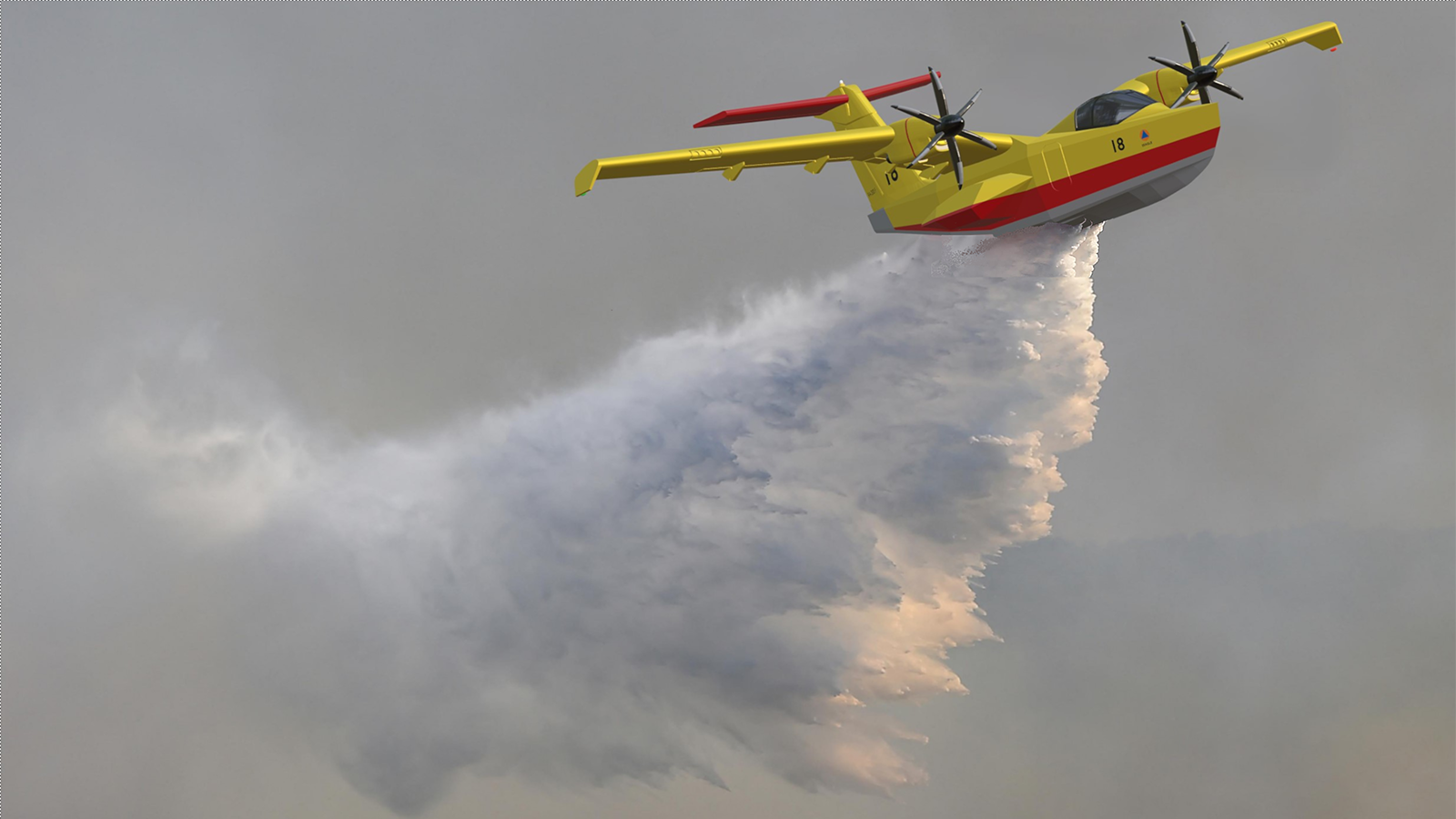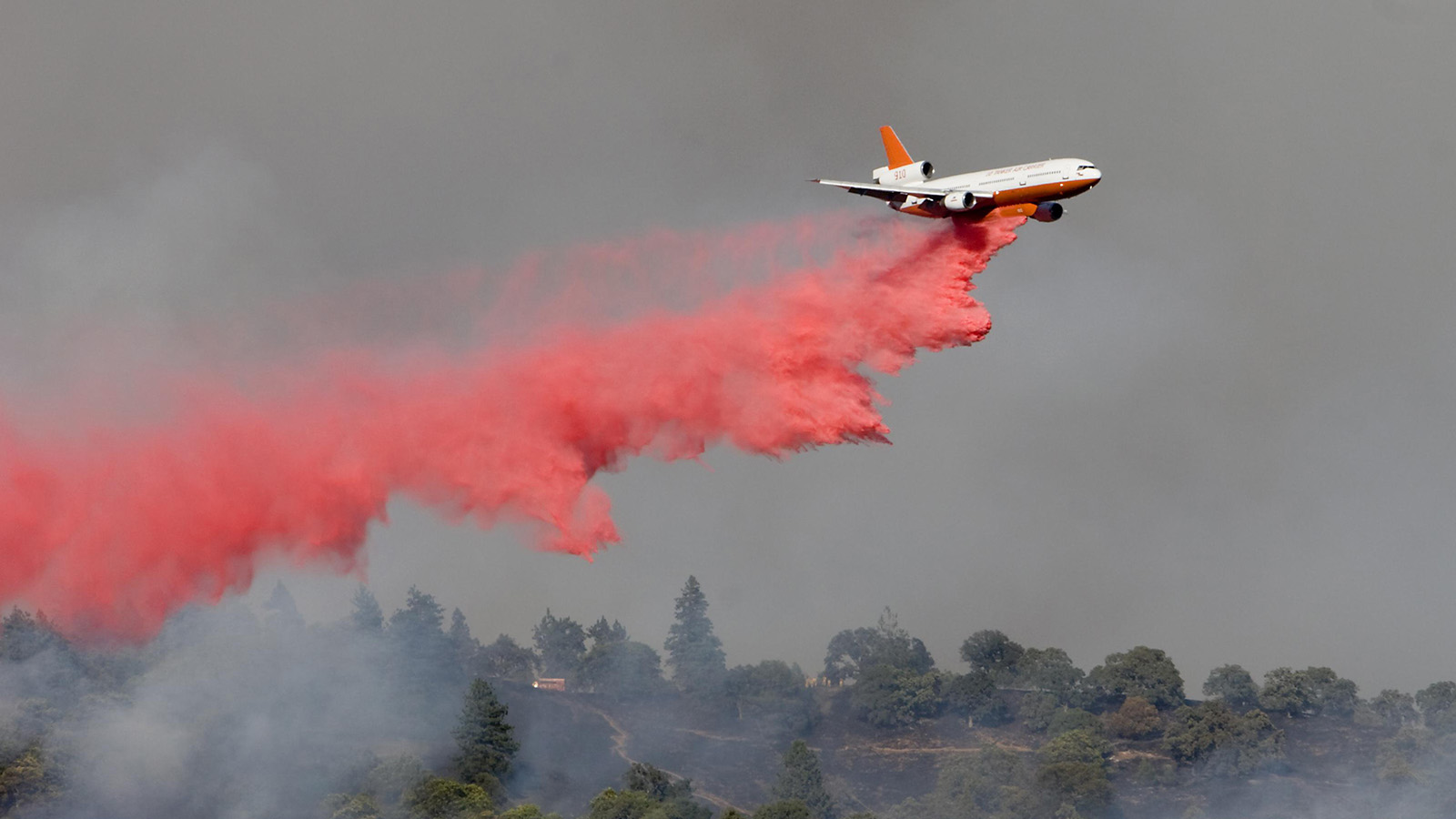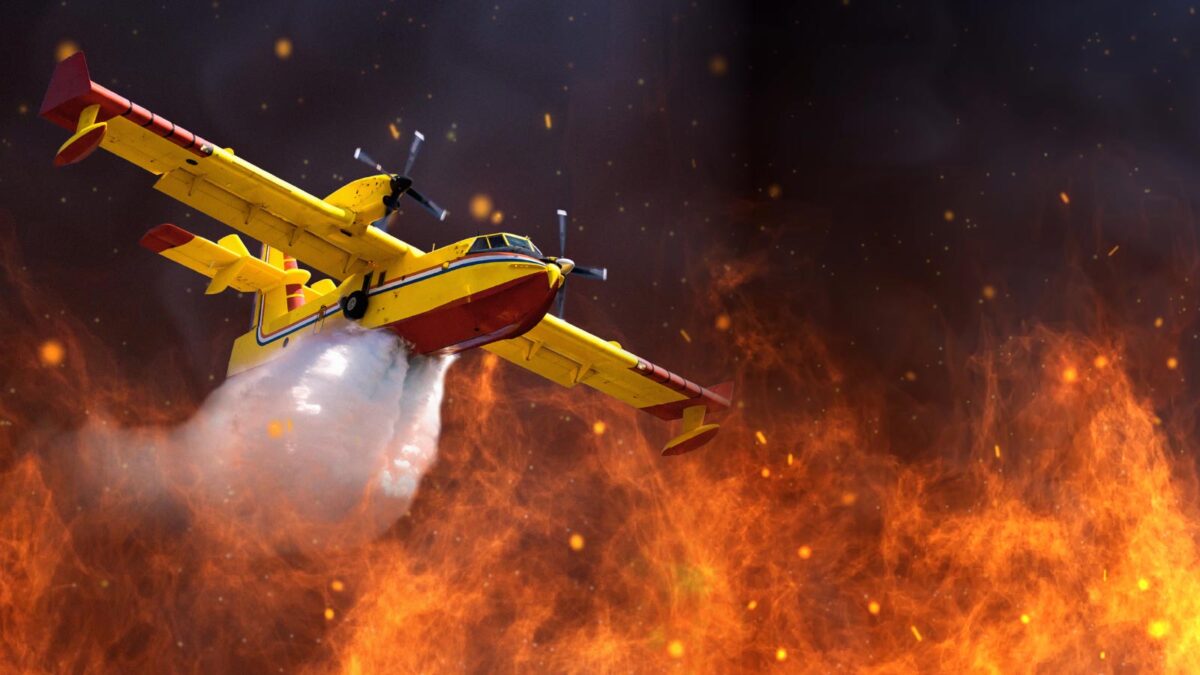Tomorrow’s firefighting fleet
By Keith Button|July/August 2023
The growing frequency and intensity of wildfires has operators clamoring to increase the number of large air tankers in their fleets. Should they turn to refurbished civilian and military planes, or clean-sheet designs? Keith Button spoke to U.S. agencies, industry groups and aircraft developers about the ongoing debate.
Even at the age of 8, living near an air tanker base in La Grande, Oregon, Jamie Knight was intrigued by the wildfire-fighting planes taking off.
“I just remember growing up all summer long watching the large air tankers,” says Knight, now the head of Oregon’s aviation firefighting operations. “There’s just something about the rumble of a low-flying aircraft as it leaves the valley here that always fascinated me.”
Later, as she fought wildfires as a ground crew member for the Oregon Department of Forestry (18 years ago), seeing large tankers appear overhead was bittersweet. “You’re really happy to see them and to know that they’re there, and it’s always really interesting and neat to see a large air tanker release its load of retardant,” she says. But the presence of those tankers also signaled to the firefighters on the ground that the stakes were raised: Their fire was now posing a serious threat to lives or property, and the tankers were being called in to slow its advance with retardant.
Today, with the threat of wildfires increasing, firefighting organizations and their backers in the United States and abroad are clamoring for more of these large tankers so they can contain fires before they grow out of control. Discussions are underway over whether the wisest course is to convert military C-130s and airliners into air tankers, or whether the time has come for a clean-sheet design.
Generally, air tankers — from the single-engine versions that carry 3,000 liters up to the very large air tankers with 30,000 liters — are called in to fight fires in the initial attack phase, to try to encircle the fire by dropping lines of retardant 6 to 15 meters from the fire’s edge to inhibit burning so ground crews can put it out. The retardant — usually a phosphate-based fertilizer and water mixed to the consistency of a slushy, dyed red for visibility — sticks to the vegetation. If the fire area continues to grow after the first 24 hours, then the task of the air tankers shifts to dropping retardant to protect areas of risk, such as residential areas.
As matters stand, proposals for clean-sheet designs to do this are rare. In Europe, Roadfour, a Brussels-based company, has started assessing the “concept and feasibility” of designing and building amphibious firefighting aircraft and making them available by 2030. The conceptual plane, dubbed the Seagle, would seek customers primarily in the European Union market. By July 2024, the company plans to decide whether to move ahead with preliminary design of the aircraft, based in part on its assessment of the needs of potential government and private buyers in Europe, says Stew Clifford, head of avionics and cockpit systems at Roadfour.
Initial plans call for the Seagle to be capable of scooping up 11,000 liters of water from the surfaces of lakes, rivers or seas, or landing at an airport to load up with a similar amount of retardant. Originally, plans called for including four hydrofoils that would keep the plane above the water’s surface during scooping, plus a “slicer” to direct water into the plane. Clifford says the hydrofoils were dropped from the plans for the 2030 version of the plane out of concern that the new technology might delay certification by the European Union Aviation Safety Agency.
Proposals for clean-sheet designs remain rare, even as the threat of fires in the U.S. and abroad looks poised to continue growing. The number of large forest fires in the American West and Alaska has increased since the early 1980s and will continue to increase due to climate warming, predicts the U.S. Global Change Research Program, a congressionally mandated organization that coordinates climate research. In the first half of June, air quality as far south as Alabama was affected by wildfires in Canada that burned 5.3 million hectares, a 1,597% increase from the year-to-date average, creating the worst daily air pollution in history for New York City. In Australia, the Black Summer 2019-2020 bush fire season burned 10.3 million hectares — the costliest natural disaster ever for the country. In 2020, California recorded five of the seven largest wildfires in its history, and the entire U.S. had the second-worst wildfire season since records began in 1983, with 4.1 million hectares burned. And over the last decade, the number of people in the U.S. experiencing unhealthy levels of wildfire smoke has increased 27-fold, according to a 2022 study by Stanford University researchers.
For Russ Lane, wildland fire chief for the state of Washington, the scope and severity of wildfires has changed a lot since his start in fire management in Oregon 36 years ago. “The amount of fuel buildup we have in the landscape, the intensity of fires — that is different,” Lane says. “We used to consider a large fire as 5,000 to 10,000 acres, and now we’re talking about fires in the tens of thousands to hundreds of thousands of acres.”
As the wildfire threat has escalated, so has the need for more firefighting aircraft, especially for large tankers capable of dumping upward of 11,000 liters of fire retardant per flight, says Paul Petersen, executive director of the United Aerial Firefighters Association, which formed last year to represent the industry before the U.S. federal and state governments.
“What we have seen, especially in the last 10 to 15 years, is the scope, size and scale of fires have just tremendously, exponentially, grown. And it is outpacing a lot of the crews and equipment that’s out there, whether that is crews that are on the ground, dozers, but also air tankers and helicopters,” says Petersen, who formerly was the Nevada state fire management officer for the U.S. Bureau of Land Management.
If additional tankers were available, they could be stationed on the ground, ready to be deployed on the initial attack so a wildfire can be contained while it’s still small, Petersen says.
This containment strategy is illustrated by the California Department of Forestry and Fire Protection, better known as Cal Fire, which says it has the largest civil aerial firefighting fleet in the world. Cal Fire’s goal is to stop 95% of the state’s fires at 10 acres or less, says Joshua Nettles, who oversees fixed-wing firefighting operations. Based on the initial 911 call, Cal Fire dispatches two S-2T air tankers — a medium-sized design that can carry 4,500 liters of retardant — as part of its first response, rather than waiting to verify that the call was not a prank or mistake. These planes are airborne within three minutes.
“Our theory is we’d rather hit it when it’s small and controllable to be able to put it out than to use that precious time where we could have stopped it to just to send somebody to verify,” he says.
Cal Fire, like other organizations contacted for this article, sees a need to add large air tankers to the overall fleet to deploy against wildfires, and the agency has agreed to acquire seven C-130H military planes that will be converted for that purpose.
The shortage of large tankers in the U.S. dates back to 2002, Petersen says, when two heavy air tankers crashed during separate firefighting missions after their wings broke off due to structural fatigue cracks. One plane was flown by the U.S. Navy starting in 1945; the other by the U.S. Air Force in 1957. After the crashes, the U.S. Forest Service and Bureau of Land Management tightened their specifications for heavy air tankers. Before 2002, there were about 45 heavy air tankers available in the U.S., with “heavy” defined as being capable of carrying at least 9,100 liters of retardant. Today in the U.S., there are 27 heavy air tankers that can carry 11,000 liters of retardant, plus four “very large air tankers” — DC-10s that carry 35,600 liters each. All are repurposed from their previous service as passenger airliners, and all are privately owned and contracted to the government for firefighting.
The problem of how to stock the nation’s aviation firefighting fleet is also a topic in Congress. In January, a commission established by the 2021 U.S. Infrastructure Investment and Jobs Act published its “Aerial Equipment Strategy Report” recommending to Congress that surplus military aircraft and parts be made readily available to state and local wildfire agencies and to private contractors. This group, the Wildland Fire Mitigation and Management Commission, also recommended that Congress commission a study to evaluate the feasibility of modifying additional aircraft and developing more “purpose-built” aircraft — a category that the commission does not define, but could include clean-sheet designs or existing aircraft expressly designed for firefighting.
Petersen’s firefighting industry group wants Congress and U.S. states to fund exclusive-use contracts between firefighting organizations and the companies that operate the 25 to 30 large and very large tankers out there now. The contracts would ensure that these tankers are kept on constant standby during the fire season for the next five to 10 years, depending on the length of the agreements. That way, the contractors could better amortize their acquisition and refurbishment costs. The industry group is seeking funding for more smaller tankers as well.
If the preceding were done, that would still leave the question of how to buttress the fleet with additional large tankers. While a clean-sheet design would be expensive, the costs of buying and converting an existing aircraft would be significant too: between $2 million and $8 million for the plane, depending on its lifespan and condition; plus the added expense of designing and manufacturing the tanking system; getting it certified by FAA, the Forest Service and the U.S. Department of the Interior; and installing it, says Nicholas Lynn, vice president of operations for Neptune Aviation Services, a Montana-based operator of nine BAe 146 tankers, each of which can hold 11,000 liters.
At Cal Fire, with an influx of large fires over the last five to 10 years in California, the agency needed to add bigger air tankers to its fleet. It has 26 of the 4,500-liter 2-T tankers, which are refurbished S-2E/G anti-submarine U.S. Navy planes.
These tankers can be flown down quickly into canyons to dump retardant, and they can be flown from smaller airports more easily than heavy tankers, Nettles says. But with a 15,000-liter capacity, a C-130H tanker can build a retardant fire line three or four times longer. For large fires, Cal Fire typically employs the tactic of building long retardant lines along ridges away from the fire. “When you’re just building line, that’s where the larger tankers really come into play,” Nettles says.
For Cal Fire’s purposes, Nettles says either repurposed civilian or military aircraft can work well for firefighting duties, but the military aircraft is often preferable for cost reasons: A former U.S. military plane can be provided for free to the state through the Federal Excess Personal Property program, Nettles says. Through the program, Cal Fire acquired its S-2T planes and agreed to acquire and operate the seven C-130H planes, which were flown by the U.S. Coast Guard starting in 1985.
Firefighting plane operators in the private sector also seem to be gravitating toward larger air tankers — those with a capacity of at least 11,000 liters — to combat the large fires that are becoming more common, Nettles says. “That’s where the trend is going, and that’s where the private market has found their niche: delivering or contracting tankers on the larger side.”
Cal Fire would certainly consider a new clean-sheet-design firefighting airplane, if one were on the market, but he says the manufacturer of such a plane would find it difficult to cover its development and building costs while competing with the prices for planes available for refurbishing, especially when states can acquire federal planes for free, not including the refurbishing costs.
“The price point is what really comes into play for us and, honestly, for most government entities or anybody that operates air tankers,” he says.
Petersen of the aerial firefighters association believes there could be room in the market for a dedicated large tanker built specifically for fighting fires. Currently, the only planes designed and built expressly as firefighting tankers operating in the U.S. are CL-415 Super Scoopers, which skim the surface of rivers, lakes or oceans to ingest up to 6,000 liters of water to drop on a fire, cooling it enough for ground crews to put it out. There are only 11 CL-415s operating in the U.S., he says.
As it is with scooper aircraft, heavy tankers expressly designed and built for dropping retardant would benefit wildland firefighting because the in-flight demands are unique: “The way that these aircraft are flown on fires is unlike anything else that’s in the military or definitely flying passengers around,” Petersen says.
A passenger plane just has to fly point to point, with 0.5-g turns, a climb to cruising altitude and a descent. Meanwhile, a firefighting tanker is always operating in the summer heat when the air is less dense, making it harder to take off and maneuver at the fire with heavy loads. Then, it has to fly at 45 meters above the vegetation or lower while avoiding power lines and dead tree snags, drop its entire load in 10 to 15 seconds, climb out, land and repeat the process — all while flying in and around the occasional thunderstorm and updrafts or downdrafts created by the fires.
“It’s definitely exciting; there’s a certain air of adrenaline,” says Bradley Baker, lead air tanker pilot for Amentum, a company that supplies Cal Fire’s pilots. “Fire creates its own weather. That’s the hardest part.”
A pilot can take off in dead calm air, 25 kilometers away, but encounter a 20-knot wind shear or 30-knot crosswind at the fire. But pilots learn to read the wind directions from the fire’s smoke, Baker says. “It’s just a giant windsock.”
For their parts, Washington fire chief Lane and the Oregon firefighting executive Knight both have their doubts about the viability of a theoretical clean-sheet-design tanker versus the refurbished options.
“For the foreseeable future, I think that you’ll continue to see a lot of use of the refurbished, repurposed aircraft,” partly because of the economics, says Knight, whose state has an 11,000-liter MD-87 air tanker under exclusive-use contract for firefighting.
Lane says, “There’s a lot of varieties out there; there’s a lot of opportunity,” but “I doubt that we’ll see the purpose-built large air tankers because it has worked really well to convert civilian airliners.”
Also, the heavy tanker fleet in the U.S. has been updated to significantly newer planes in the past several years. “Not too many years ago in Oregon, we were flying DC-7s that were way older than I was,” he says.
Neptune Aviation’s Lynn is another skeptic. “To get a manufacturer to tool up, design, build and produce, the economics just aren’t there,” he says. “What that would do to the costs for the contractor and the government would be prohibitive, in my mind.”











